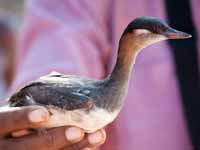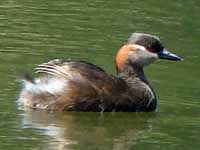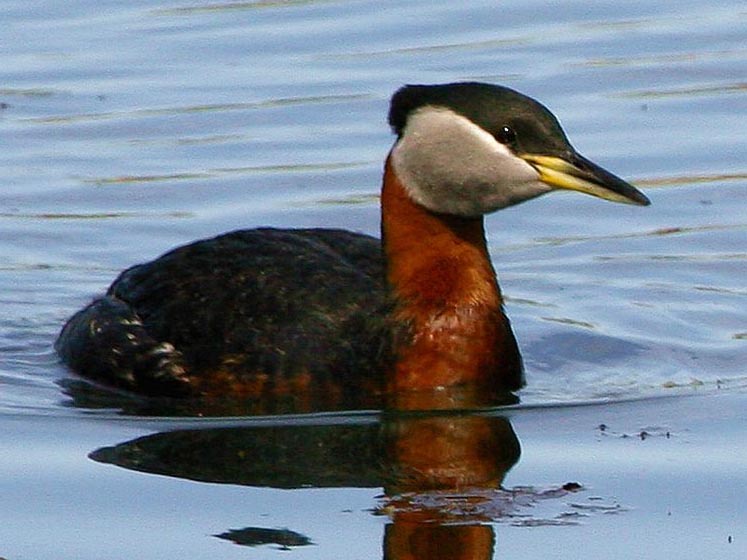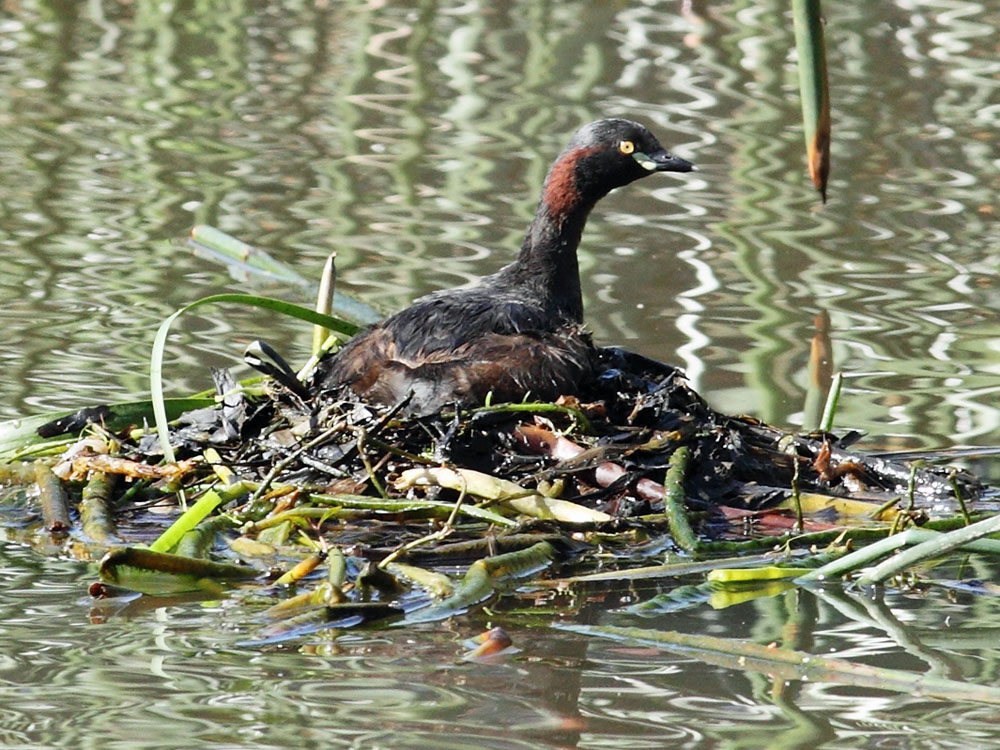The grebe family Podicipedidae is the only member of the Podicipediformes order. They have no close relatives – perhaps flamingos are the closest. They have large feet with lobed toes, and are excellent swimmers and divers. However, although they can run for a short distance, they are prone to falling over, since they have their feet placed far back on the body. Grebes have narrow wings, and some species are reluctant to fly; they respond to danger by diving rather than flying. They vary from 23 to 71 cm. Bills vary from short and thick to long and pointed, depending on the diet, which ranges from fish to freshwater insects and crustaceans. Grebes make floating nests of plant material concealed among reeds on the surface of the freshwaters. They may move to more open or coastal waters when not breeding, and birds in those areas where the waters freeze are migratory.
Grebes have unusual plumage. It is dense and waterproof, and on the underside the feathers are at right-angles to the skin, sticking straight out to begin with and curling at the tip. By pressing their
feathers against the body, grebes can adjust their buoyancy. Often, they swim low in the water with just the head and neck exposed. In the non-breeding season, grebes are plain-colored in dark browns
and whites. However, most have ornate and distinctive breeding plumages, often developing chestnut markings on the head area, and perform elaborate display rituals. Females look the same as males, but average a little smaller. The young are often striped and retain
some of their juvenile plumage even after reaching full size.
Grebes swallow large quantities of their own feathers, which remain in the stomach. Parents even feed feathers to their young. Perhaps having decomposed feathers in the stomach help protect against share materials such as bones?
Genus Aechmophorus
At one time, the Clark's green and western grebe were consider to be conspecific. They are very similar in all aspects. These grebes nest in vegetation which emerges from the water and provides support for the nest plus protection from waves.
Grebe,_Clark's Aechmophorus clarkii Found: west North America (southeast Alaska to north Mexico)
Range: Western North America, including Mexico.
Habitat: Lakes and wetlands which have an adequate food and shelter supply. Both salt and fresh water.
Diet: Mainly fish. Also crustaceans and worms. Swims under water after prey which it may spear with its long and pointed bill or grasp with the bill. Larger prey is speared, smaller is grasp.
Conservation status: Least Concern.
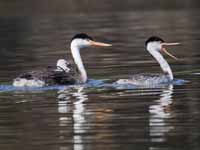

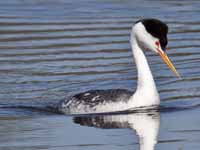

Grebe,_Western Aechmophorus occidentalis
Range: Western North America (southeast Alaska to north Mexico).
Habitat: Lakes and wetlands which have an adequate food and shelter supply. Mainly fresh water.
Diet: Mainly fish. Also crustaceans and worms. Swims under water after prey which it may spear with its long and pointed bill or grasp witht the bill. Larger prey is speared, smaller is grasp.
Conservation status: Least Concern.
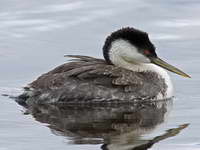
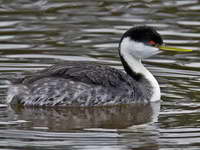
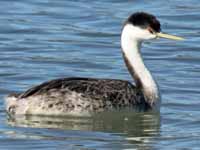
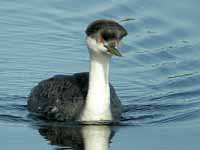
Genus Podiceps Found on: All continents (except Antarctica)
Adults have striking breeding plumage, with no difference between the sexes. In winter, the plumage is subdued whites and greys. The name podiceps refers to the legs that are placed far back on the body. That placement is good for swimming and chasing fish underwater, but makes walking awkward. There are usually two juveniles - they are striped and may ride on a parent's back while small. Most northern hemisphere species migrate to the coast or warmer climates during winter.
Grebe,_Eared Podiceps nigricollis
Range: Mainly North and Central America, Europe, western Asia. Also eastern Asia and Africa. Eared grebes are the most plentiful of all the grebe species.
Habitat: Saline lakes and coastal estuaries, except fresh water lakes during breeding season.
Diet: Insects which are found on the water surface; also dives for fish, crustaceans including shrimp, frogs.
Conservation status: Least Concern.
1, 2) Nonbreedeing 3, 4) Breeding
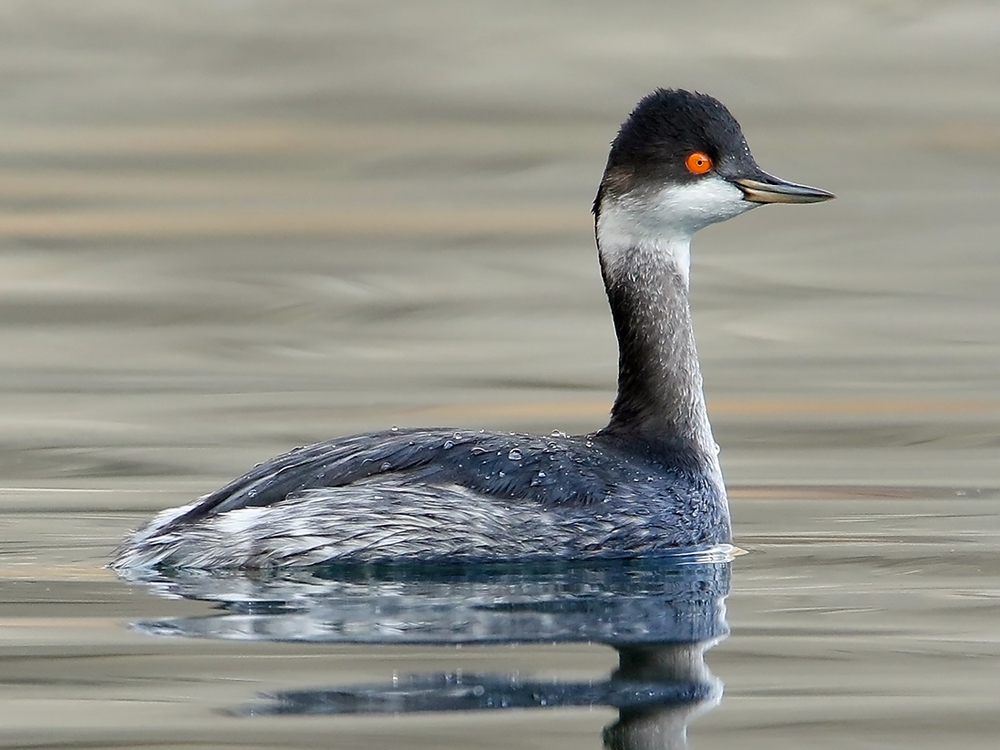
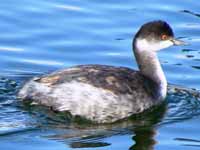

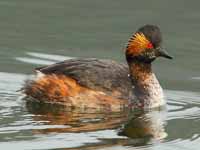
Grebe,_Great Podiceps major
Range: South America - along the west coast and also the southern part or South America.
Habitat: In general utilizes fresh water during breeding season. Otherwise prefers coastal waters and estuaries.
Diet: Mainly fish; also crustaceans, insects, and mollusks.
Conservation status: Least Concern.
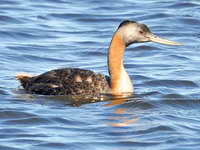
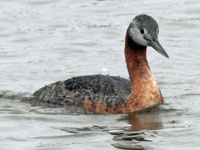
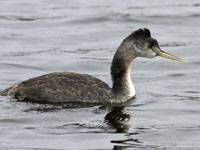

Grebe,_Great-crested Podiceps cristatus
Range: Europe, Asia, Africa, Australasia.
Habitat: During breeding season it prefers fresh waters with vegetation to conceal and protect the nest plus open waters for pursuing fish. Otherwise prefers coastal waters and estuaries or large open freshwater bodies.
Diet: Mainly fish; also crustaceans, insects, frogs.
Conservation status: Least Concern.
1, 2) nonbreeding 3, 4) Breeding
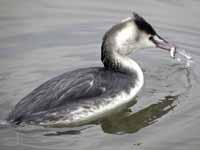
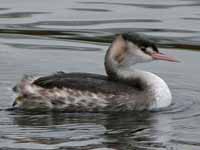
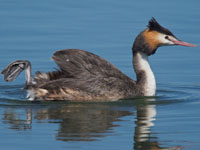
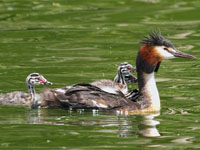
Grebe,_Hooded Podiceps gallardoi
Range: Southern South America.
Habitat: Isolated lakes of Patagonia except it spends the winter near the coast.
Diet: Mainly snails; also insect larvae and insects.
Conservation status: It is listed as Critically Endangered. Its population is declining, probably because of a lack of its food source. Introduced trout are thought to be related to the problem.
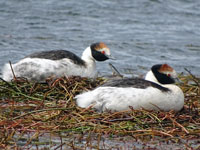


Grebe,_Horned Podiceps auritus
Range: The northern hemisphere.
Habitat: Small ponds and secluded parts of lakes with emergent vegetation for breeding, but also open area for foraging. During the winter it favors coastal areas.
Diet: Airborne arthropods favored in summer; fish and crustaceans favored in the winter.
Conservation status: It is listed as Vulnerable because in many locations its population is declining. That said, there are probably over a quarter million horned grebes so they are far from extinction and may actually be increasing in North America.
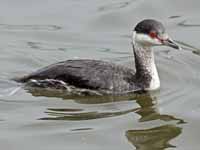
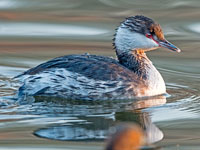
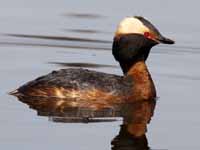
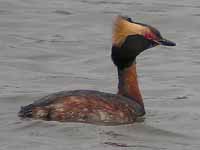
Grebe,_Junin Podiceps taczanowskii
Range: Lake Junin in the highlands of west-central Peru.
Habitat: It breeds in reed beds at the edge of the lake and also roosts in the area; otherwise it forages far from the shore.
Diet: Small fish and invertebrates.
Conservation status: It is listed as Endangered as it has a small range and the population is only about 250.
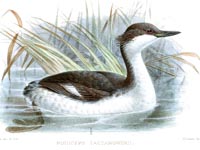

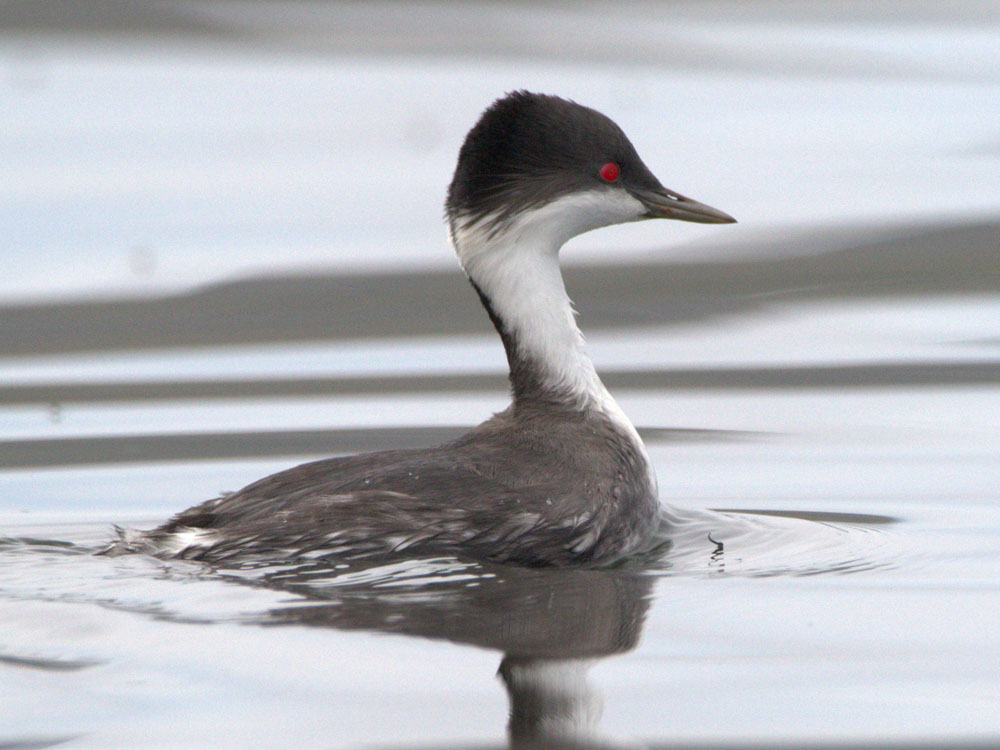
Grebe,_Red-necked Podiceps grisegena
The red-necked grebe, except for migration, does not fly much; instead prefering to swim above water or to dive below. During breeding season they are noisy and defend their territory. At other times they are more passive.
Range: Northern parts of Eurasia and North America.
Habitat: Breeding sites are fresh water sites with abundant vegetation for nests. Nonbreeding sites are salt water bays and estuaries from which they may venture further out for fish.
Diet: Fish, crustaceans, insect, larvae. Dives for fish while gathers insects and larvae from vegetation.
Conservation status: Least Concern.
1) Nonbreeding 2) Breeding with young 3, 4) Breeding

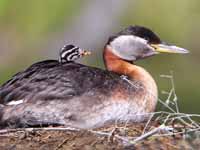

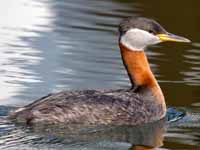
Grebe,_Silvery Podiceps occipitalis
Range: Southern and western South America.
Habitat: Breeds on freshwater with reeds available for nests and open water for foraging. Other than breeding season, usually found on saline lakes.
Diet: Aquatic arthropods such as insects and insect larvae. Also crustaceans.
Conservation status: Least Concern.
1, 2) Andean silvery grebe 3) Paragonian silvery grebe
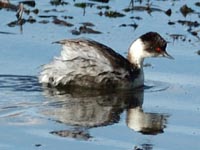

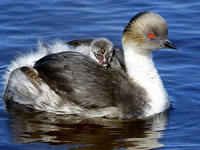
Genus Podilymbus - 1 species
Grebe,_Pied-billed Podilymbus podiceps
Range: The Americas.
Habitat: Usually in fresh water bodies that have emergent vegetation such as cat tails and reeds plus some open water available. Those that live where water freezes in the winter migrate.
Diet: Fish, aquatic invertebrates, frogs.
Conservation status: Least Concern.
1) Juvenile 2) Nonbreeding 3) Breeding

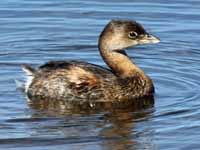
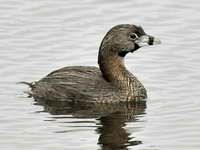
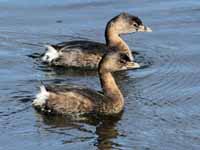
Genus Poliocephalus Found in: Australasia
Grebe,_Hoary-headed Poliocephalus poliocephalus
Range: Mainly Australia; also New Zealand.
Habitat: Water bodies that have large open areas. The water may be fresh or brackish.
Diet: Aquatic arthropods. It deep dives for food in good light and feeds on the surface in poor light.
Conservation status: Least Concern.
1) Chick 2. 3) Breeding

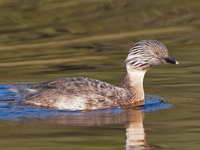
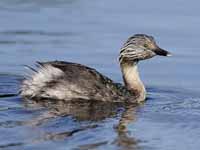
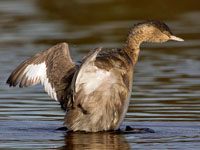
Grebe,_New Zealand Poliocephalus rufopectus
Range: New Zealand.
Habitat: Shallow freshwater lakes and ponds.
Diet: Mainly aquatic insects and their larvae which are captured on the surface. Also dives for snails and fish.
Conservation status: It is listed as Near Threatened because its range has reduced to the North Island and the population seems to be declining from lack of nesting sites and perhaps increased boat traffic.
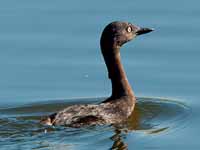
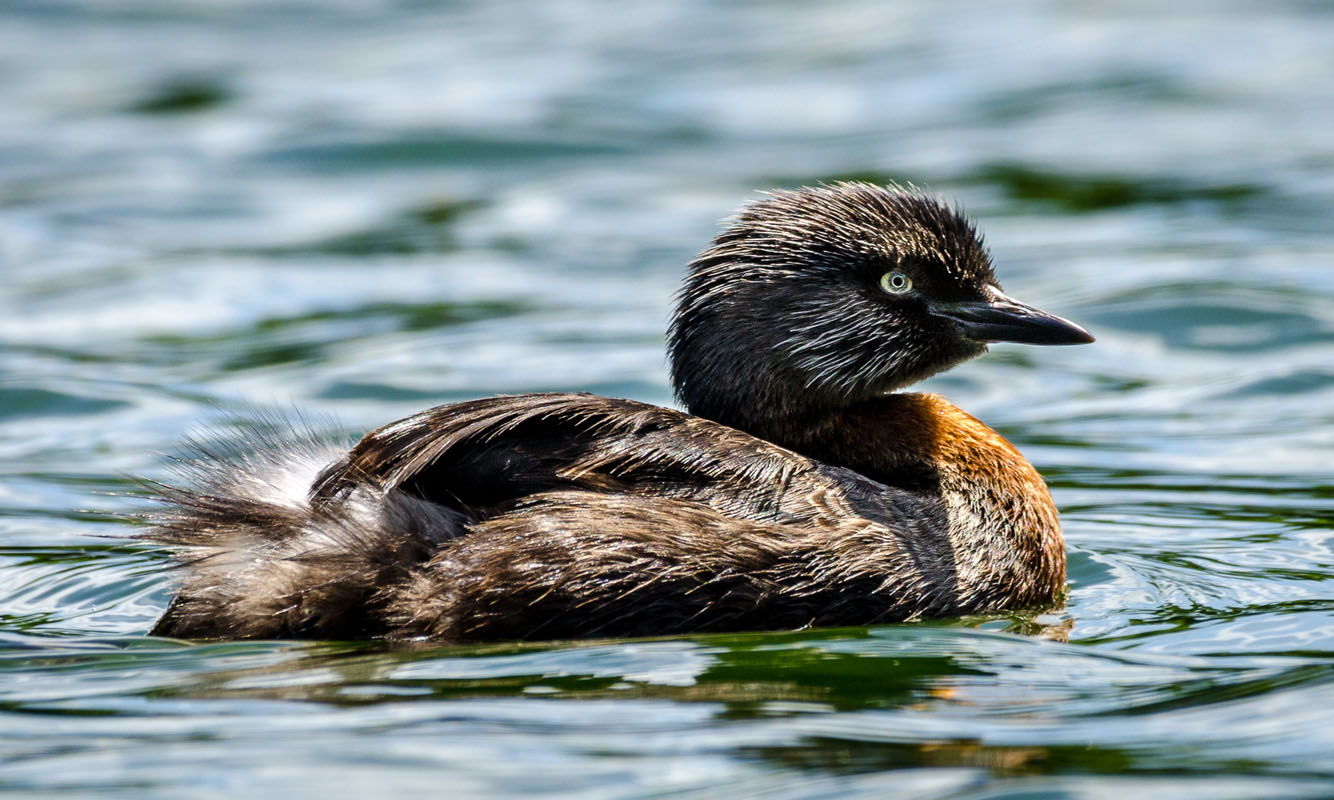
Genus Rollandia Found in: South America
Grebe,_Titicaca Rollandia microptera
Range: Bolivia, Peru. It is mainly found on Lake Titicaca.
Habitat: Lake Titicaca is large, with a substantially amount of reeds which is where this grebe has its nest.
Diet: Mainly fish, up to 15 cm long.
Conservation status: It is listed as Endangered with a population less than 750, but hopefully it has stabilized.
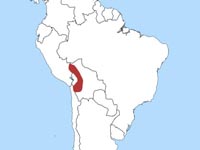
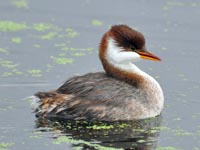
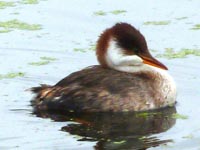
Grebe,_White-tufted Rollandia rolland
Range: From Bolivia, Chile, and Peru south to the tip of South America.
Habitat: Freshwater lakes, ponds. slow moving rivers.
Diet: Mainly fish; also aquatic arthropods. Forages for fish be peering under the surface and then making brief dives.
Conservation status: Least Concern.
1) Adult with juvenile
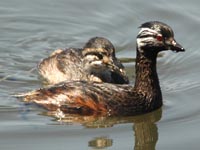
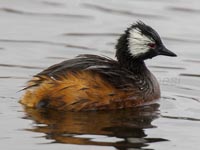
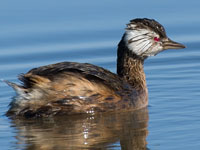
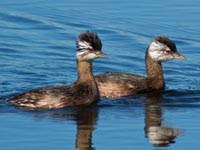
Genus Tachybaptus
The species in this genus are found on all continents except Antarctica. They are the smallest of the grebes. Except for the least grebe, during breeding season they have a white mark on their head that is not found in other grebe genera.
Grebe,_Australasian Tachybaptus novaehollandiae
Range: Australia, New Zealand, nearby islands.
Habitat: Relatively small lakes and ponds that are freshwater.
Diet: Mainly fish. Also aquatic insects, mollusks.
Conservation status: Least Concern.
1, 3, 4) Breeding 2) Nonbreeding

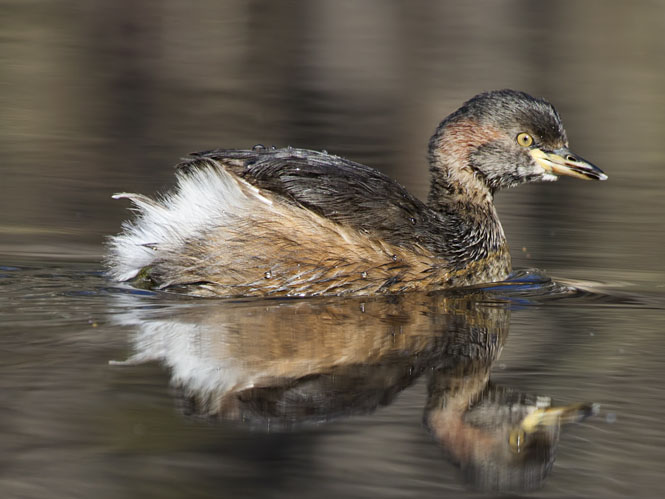


Grebe,_Least Tachybaptus dominicus
Range: Southwestern USA, Florida, Central and South America.
Habitat: Temporary ponds to lakes. Even ditches.
Diet: Fish, crustaceans, frogs and aquatic insects.
Conservation status: Least Concern.
1, 2) ) Nonbreeding 3, 4) Breeding
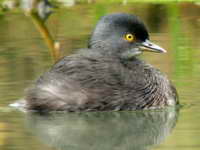
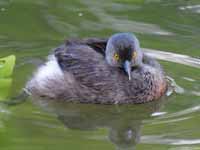
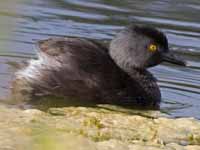
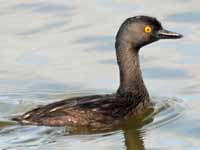
Grebe,_Little Tachybaptus ruficollis
Range: Europe, Asia, Africa, Madagascar, Australasia.
Habitat: Freshwater lakes during breeding season. Some are coastal in the winter.
Diet: Mainly aquatic insects and their larvae. Also fish, crustaceans, frogs.
Conservation status: Least Concern.
1) Chick and adult 2) Nonbreeding 3, 4) Breeding
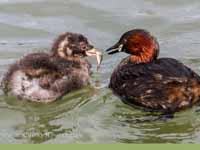
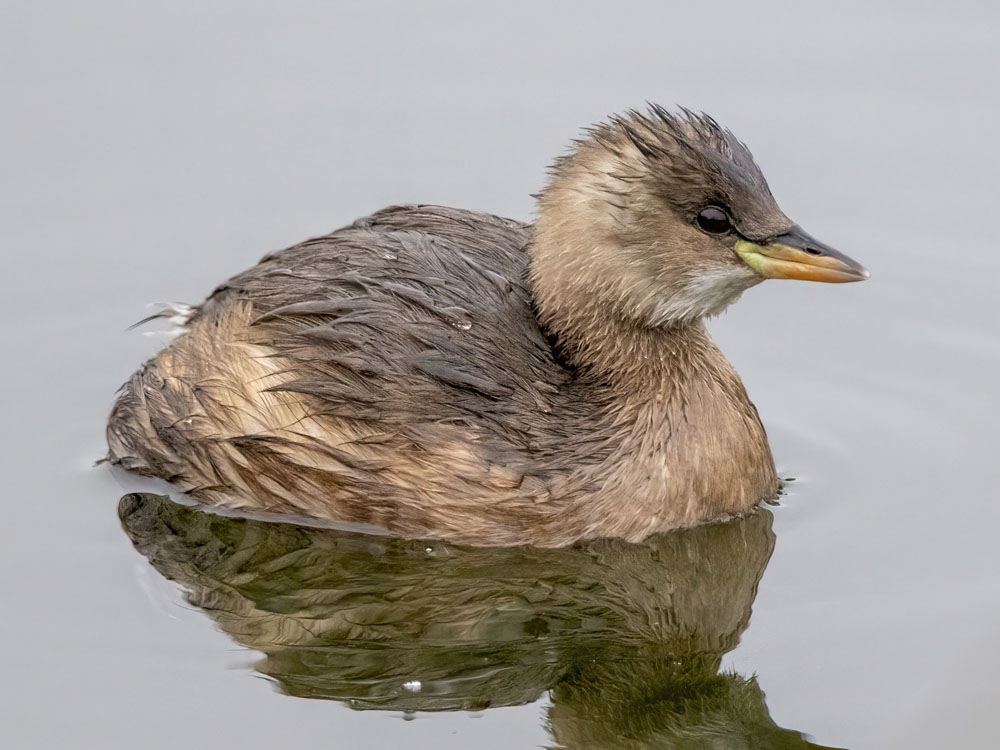
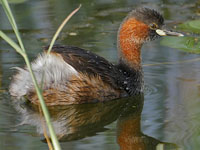
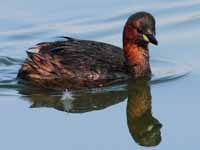
Grebe,_Madagascar Tachybaptus pelzelnii
Range: West and central Madagascar.
Habitat: Shallow freshwater lakes and pools with lily pads available for breeding.
Diet: Mainly aquatic insects; also fish, crustaceans.
Conservation status: It s listed as Endangered due to decling populations from wetland destruction.
